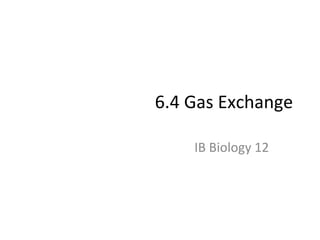
CAS IB Biology 6.4 Gas Exchange
- 1. 6.4 Gas Exchange IB Biology 12
- 2. Assessment Statements Obj. 6.4.1 Dis0nguish between ven;la;on, respira;on and gas exchange. 2 6.4.2 Explain the need for a ven;la;on system. 3 6.4.3 Describe the features of alveoli that adapt them to gas exchange. 2 6.4.4 Draw and label a diagram of the ven;la;on system, including trachea, lungs, bronchi, bronchioles and alveoli. 1 6.4.5 Explain the mechanism of ven;la;on of the lungs, in terms of volume and pressure changes caused by the internal and external intercostal muscles, the diaphragm and abdominal muscles. 3 Assessment statements from: Online IB Biology Subject Guide
- 3. Respira;on -‐ 3 Major Stages • Ven;la;on – Movement of air into and out of the lungs in two stages: inspira;on and expira;on – Controlled by movement of the diaphragm and ribcage
- 4. Respira;on -‐ 3 Major Stages • Gas Exchange – Exchange (diffusion) of oxygen and carbon dioxide to and from the blood at the alveoli and the respiring ;ssues – Controlled by movement of the diaphragm and ribcage
- 5. Respira;on -‐ 3 Major Stages • Cellular Respira;on – Produc;on of ATP at the cellular level – Aerobic respira;on: using oxygen – Anaerobic restora;on: no oxygen • SO4 2-‐, NO3 -‐, S or fumurate
- 6. Respira;on -‐ 3 Major Stages • Ven;la;on • Gas Exchange • Cellular Respira;on Respira0on is the transport of oxygen from the outside air to the cells within 6ssues, and the transport of carbon dioxide in the opposite direc6on
- 7. Why do we need a ven;la;on system?
- 8. Ven;la;on System • Smaller organisms, like pro;sts and bacteria – exchange gases directly by diffusion • Larger organisms, like fish and mammals – ul;mately use diffusion BUT – require habitat-‐dependent adap;ons to exchange gases
- 10. Why do we need ven;la;on systems? • We are large organisms – Oxygen cannot diffuse into all our cells directly from the air – Waste products cannot be removed directly from the body – Specialized organ systems require delivery of nutrients and removal of waste
- 11. Why do we need a ven;la;on system? • We are land-‐borne – Gases need moist surfaces in order to diffuse • Membranes – Our moist membranes are the lungs
- 12. Why do we need a ven;la;on system? • The ven;la;on system maintains a large concentra0on gradient between the alveoli and the blood
- 13. Why do we need a ven;la;on system? 1) Large organisms 2) Land-‐borne 3) Concentra;on gradient
- 16. Parts of the Ven;la;on System • lungs – • trachea – • bronchi – • bronchioles – • alveoli – • diaphragm –
- 17. Parts of the Ven;la;on System • lungs – major respira;on organ • trachea – the windpipe • bronchi – passages of airways • bronchioles – smaller branches of bronchi • alveoli – “li_le cavity”, gas-‐exchange surface • diaphragm – sheet of skeletal muscle that seperates the thoracic cavity from the abdominal cavity; major role in respira;on
